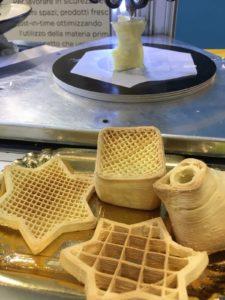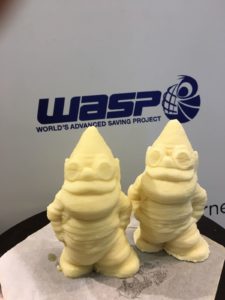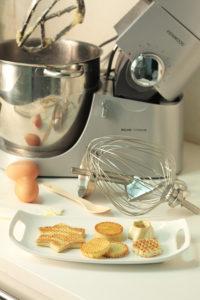 I tend to be a bit suspicious of any food-related trend, no matter how many people adopt it. The gluten-free diet is one of those trends – I can’t imagine cutting out all of the foods I regularly eat that have gluten in them, and I have friends with celiac disease who say they’d give anything to be able to eat foods with gluten again. But if it makes people feel healthier, then go for it – there are a number of gluten-free alternatives out there, and 3D printed food is no exception.
I tend to be a bit suspicious of any food-related trend, no matter how many people adopt it. The gluten-free diet is one of those trends – I can’t imagine cutting out all of the foods I regularly eat that have gluten in them, and I have friends with celiac disease who say they’d give anything to be able to eat foods with gluten again. But if it makes people feel healthier, then go for it – there are a number of gluten-free alternatives out there, and 3D printed food is no exception.
WASP is in the business of making every aspect of life easier through 3D printing, from spinal care to architecture to athletics, and a lot more. Recently, the Italian company started exploring 3D printed food. Nothing that WASP does is for novelty purposes, so the fact that it’s looking into 3D printing food is a sure sign that food printing really is finally moving from novelty chocolates to more substantive fare. According to the WASP team, they were first inspired to begin researching 3D food printing last year with the opening of Food Ink., an entirely 3D printed pop-up restaurant.
As WASP’s mission is to solve serious problems that afflict people, they began by focusing on the sector of the population that suffers from celiac disease. The illness is serious business – even small amounts of gluten-containing foods, like crumbs, can trigger reactions, so those who have the disease need to be extremely careful to keep anything they ingest away from foods that do contain gluten. This makes eating at restaurants particularly challenging, as gluten is everywhere.
WASP wants to enable restaurants to more easily create miniature gluten-free kitchens inside their regular kitchens – a difficult task as it stands now. With a 3D printer, restaurants would be able to have a separate piece of equipment strictly for preparing gluten-free foods, with no risk of contamination from the other food preparation equipment in the rest of the kitchen. The company enlisted the help of Francesco Favorito, a chef who specializes in gluten-free foods and who founded Zeroinpiú, a line of gluten-free flour and pastry mixes.
 Favorito came up with a specialized gluten-free pastry mix, and WASP modified a DeltaWASP 20 40 by incorporating an extruder that was heated to the point that it pre-cooked the mix as it was being extruded. The rest of the cooking would then take place in a normal oven. WASP introduced the printer at Sigep, a baking and coffee expo held at the end of January, and it was met with a great deal of interest from those in attendance. Another demonstration of the printer was given at Carnival in Opificio Golinelli at the beginning of February, this time with the participation of Francesco Bombardi, an architect, designer and the founder of Fab Lab Reggio Emilia. Bombardi is also the founder of Officucina, a specialized makerspace dedicated to food innovation and equipped with 3D printers, lasers, and other advanced technology.
Favorito came up with a specialized gluten-free pastry mix, and WASP modified a DeltaWASP 20 40 by incorporating an extruder that was heated to the point that it pre-cooked the mix as it was being extruded. The rest of the cooking would then take place in a normal oven. WASP introduced the printer at Sigep, a baking and coffee expo held at the end of January, and it was met with a great deal of interest from those in attendance. Another demonstration of the printer was given at Carnival in Opificio Golinelli at the beginning of February, this time with the participation of Francesco Bombardi, an architect, designer and the founder of Fab Lab Reggio Emilia. Bombardi is also the founder of Officucina, a specialized makerspace dedicated to food innovation and equipped with 3D printers, lasers, and other advanced technology.
According to WASP, a lot was learned from the early trials; for example, the addition of heated butter increased fluidity and helps the mixture extrude more smoothly, and even though the main purpose of the printer is to create safe foods for people with celiac disease, that doesn’t mean it can’t be used to to create fancy and complex shapes that would be impossible to create by normal methods.
- Gluten-free gnomes!
WASP still has quite a bit of research, development and refining to do. The extruder needs to be compatible with strict sanitary regulations, and they’re also looking to create a more intuitive, user-friendly software. I’m wondering if they’ll also come up with a way to cook the food in a way that doesn’t require the use of the main oven in a restaurant kitchen. It’s a big first step, though, in better accommodating the needs of those with gluten allergies – and, as WASP points out, the same technology can also be used to cater to other dietary needs. In addition, zero waste is a major priority for WASP, and 3D printing also allows for customized portion sizes, the better to cut down on food waste. You can see a quick demonstration below:
Discuss in the Gluten-Free 3D Printing forum at 3DPB.com.
Subscribe to Our Email Newsletter
Stay up-to-date on all the latest news from the 3D printing industry and receive information and offers from third party vendors.
You May Also Like
3D Printing Unpeeled: Biofuel Waste to Filament & Sustainable Photopolymers
I can’t ever remember a day with so many potentially high impact news stories have come out. In one story, we all know that there are problems with the safety...
Finnair Hires AM Craft to 3D Print Plastic Parts for Aircraft Interiors
Riga-based AM Craft, a supplier specialized in 3D printing aviation components and certified under EASA Part 21G, announced a significant achievement today. The company will assist in upgrading Finnair’s A320...
3DPOD Episode 198: High Speed Sintering with Neil Hopkinson, VP of AM at Stratasys
Neil Hopkinson, a pioneering 3D printing researcher, played a pivotal role in developing a body of research that is widely utilized today. He also invented High Speed Sintering (HSS), also...
3D Printing Webinar and Event Roundup: May 12, 2024
Webinars and events are picking up in the AM industry this week! ASTM International continues its Professional Certificate Course and Stratasys continues its advanced in-person trainings, while 3D Systems is...





































